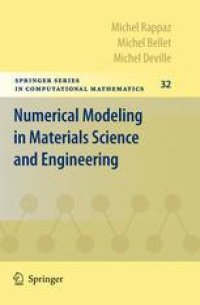
Ebook: Numerical Modeling in Materials Science and Engineering
- Tags: Computational Mathematics and Numerical Analysis, Characterization and Evaluation of Materials, Mechanical Engineering, Condensed Matter Physics
- Series: Springer Series in Computational Mathematics 32
- Year: 2003
- Publisher: Springer-Verlag Berlin Heidelberg
- Edition: 1
- Language: English
- pdf
This book introduces the concepts and methodologies related to the modelling of the complex phenomena occurring in materials processing. After a short reminder of conservation laws and constitutive relationships, the authors introduce the main numerical methods: finite differences, finite volumes and finite elements. These techniques are developed in three main chapters of the book that tackle more specific problems: phase transformation, solid mechanics and fluid flow. The two last chapters treat inverse methods to obtain the boundary conditions or the material properties and stochastic methods for microstructural simulation. This book is intended for undergraduate and graduate students in materials science and engineering, mechanical engineering and physics and for engineering professionals or researchers who want to get acquainted with numerical simulation to model and compute materials processing.
This book introduces the concepts and methodologies related to the modelling of the complex phenomena occurring in materials processing. After a short reminder of conservation laws and constitutive relationships, the authors introduce the main numerical methods: finite differences, finite volumes and finite elements. These techniques are developed in three main chapters of the book that tackle more specific problems: phase transformation, solid mechanics and fluid flow. The two last chapters treat inverse methods to obtain the boundary conditions or the material properties and stochastic methods for microstructural simulation. This book is intended for undergraduate and graduate students in materials science and engineering, mechanical engineering and physics and for engineering professionals or researchers who want to get acquainted with numerical simulation to model and compute materials processing.
This book introduces the concepts and methodologies related to the modelling of the complex phenomena occurring in materials processing. After a short reminder of conservation laws and constitutive relationships, the authors introduce the main numerical methods: finite differences, finite volumes and finite elements. These techniques are developed in three main chapters of the book that tackle more specific problems: phase transformation, solid mechanics and fluid flow. The two last chapters treat inverse methods to obtain the boundary conditions or the material properties and stochastic methods for microstructural simulation. This book is intended for undergraduate and graduate students in materials science and engineering, mechanical engineering and physics and for engineering professionals or researchers who want to get acquainted with numerical simulation to model and compute materials processing.
Content:
Front Matter....Pages i-xi
Continuous Media....Pages 1-45
The Finite Difference Method....Pages 47-92
The Finite Element Method....Pages 93-147
Elements of Numerical Algorithms....Pages 149-205
Phase Transformations....Pages 207-285
Deformation of Solids....Pages 287-364
Incompressible Fluid Flow....Pages 365-445
Inverse Methods....Pages 447-475
Stochastic Methods....Pages 477-515
Appendices....Pages 517-534
Back Matter....Pages 535-540
This book introduces the concepts and methodologies related to the modelling of the complex phenomena occurring in materials processing. After a short reminder of conservation laws and constitutive relationships, the authors introduce the main numerical methods: finite differences, finite volumes and finite elements. These techniques are developed in three main chapters of the book that tackle more specific problems: phase transformation, solid mechanics and fluid flow. The two last chapters treat inverse methods to obtain the boundary conditions or the material properties and stochastic methods for microstructural simulation. This book is intended for undergraduate and graduate students in materials science and engineering, mechanical engineering and physics and for engineering professionals or researchers who want to get acquainted with numerical simulation to model and compute materials processing.
Content:
Front Matter....Pages i-xi
Continuous Media....Pages 1-45
The Finite Difference Method....Pages 47-92
The Finite Element Method....Pages 93-147
Elements of Numerical Algorithms....Pages 149-205
Phase Transformations....Pages 207-285
Deformation of Solids....Pages 287-364
Incompressible Fluid Flow....Pages 365-445
Inverse Methods....Pages 447-475
Stochastic Methods....Pages 477-515
Appendices....Pages 517-534
Back Matter....Pages 535-540
....